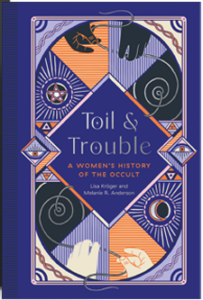Toil & Trouble. A women’s history of the occult
Lisa Kröger and Melanie R. Anderson
Quirk Books, 2022. 288 p. ISBN 978-1-68369-291-1. € 24,95
“Women have used the occult as a positive force, as a way for the disenfranchised to gain more agency in society.”
“Women have routinely been drawn to this tradition, in part because US society, with its Christian roots, has always placed the white male at the top of the patriarchal structure. In a way, women have always existed in occulted space. They were meant to be hidden; their role was one that existed behind the scenes, as caretaker of the family and keeper of the home. Their role was never intended to be public – that is, until the occult world told them that they could step forward and take control of their own destiny.”
“The occult does seem to be a form of rebellion.”
These phrases from the introduction set the stage. “The occult” means that what is hidden, and more in particular “the supernatural”. For many of the women portrayed it meant a way to make money or gain influence. Sometimes it may have been the only way, because other options were closed. Making a fortune by telling the fortune, and reaching political gain more or less unnoticed. For others it was their chance for rebellion and causing changes. Women and nonbinary people from Europe and the Unites States may have needed to hide in the past – ‘witch’ was in the past a dangerous word to be associated with. Nowadays on TikTok “the hashtag #witchtok garnered more than two billion views in 2019 and 2020”.
The book is divided into five sections:
1. Designing witches. Shaping the occult.
2. The spirits got to Washington. Politicizing the occult.
3. Ghosts and glory. Monetizing the occult.
4. Paranormal investigation. Challenging the occult.
5. 100% that witch. Embracing the occult.
A bibliography and an index are also included.
Meet Dion Fortune, Marie Laveau, Pamela Colman Smith, Helena Blavatsky, Margaret Murray and Doreen Valiente, Starhawk, Selena Fox, Carol P. Christ, Silver Ravenwolf; women from Salem then and now; the spiritual advisor of the Nancy and Ronald Reagan; Houdini’s psychic advisor; novelist Harriet E. Wilson; Helen Peters Nosworthy – “the woman who built ouija”; women from the spiritualist movement; the activist collective ‘WITCH’ that was formed in 1968; “the witches who hexed Trump”; women in the satanic scare period; Margaret St. Clair – “the writer who brought Wicca to science fiction”; Stormy Daniels – “porn star turned paranormal investigator”; Brandi Blackbear; and many others.
Into and in between their stories a fair amount of history has been woven, and Kröger and Anderson explain the sociological settings of the times. Very interesting!

